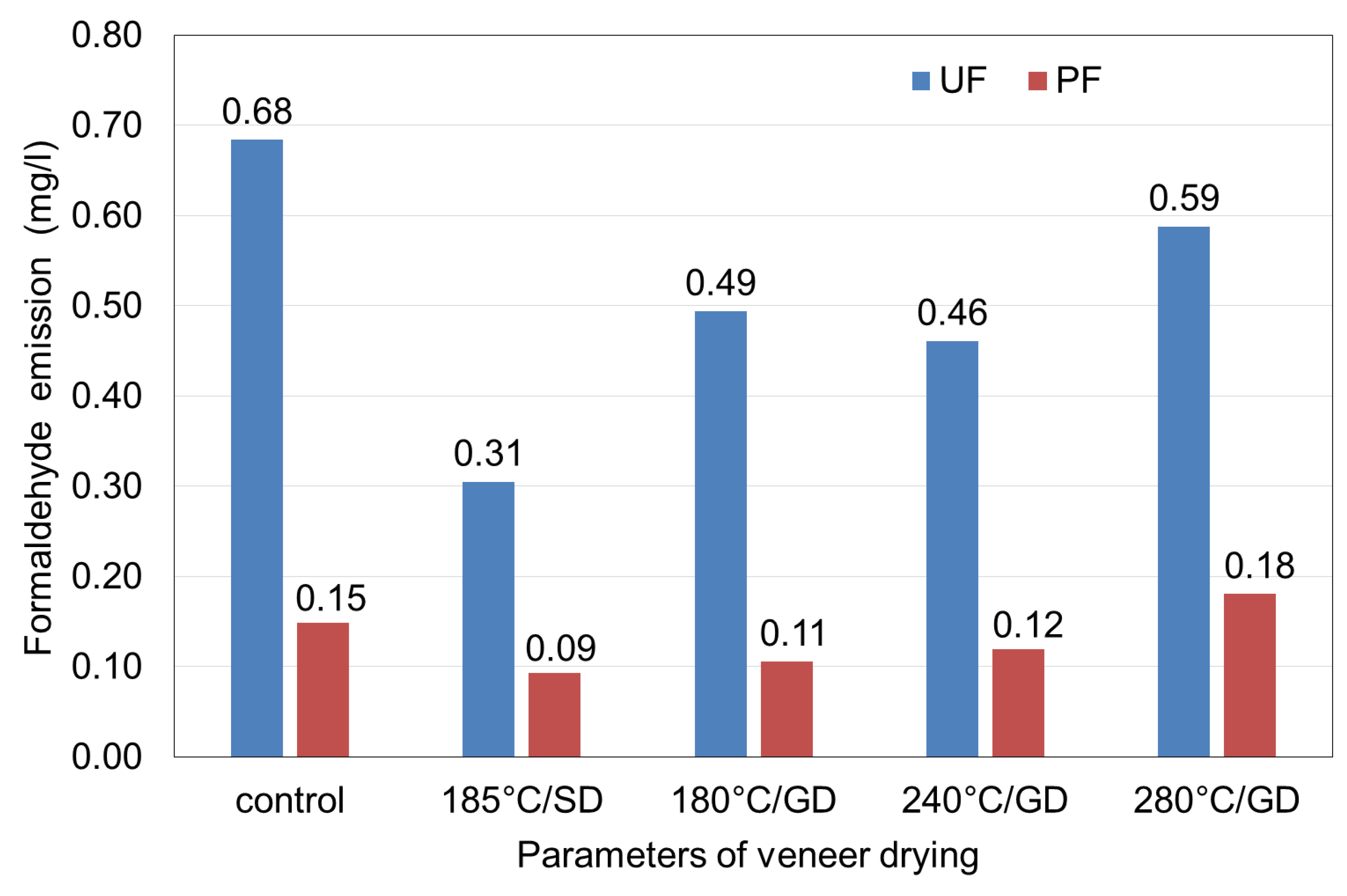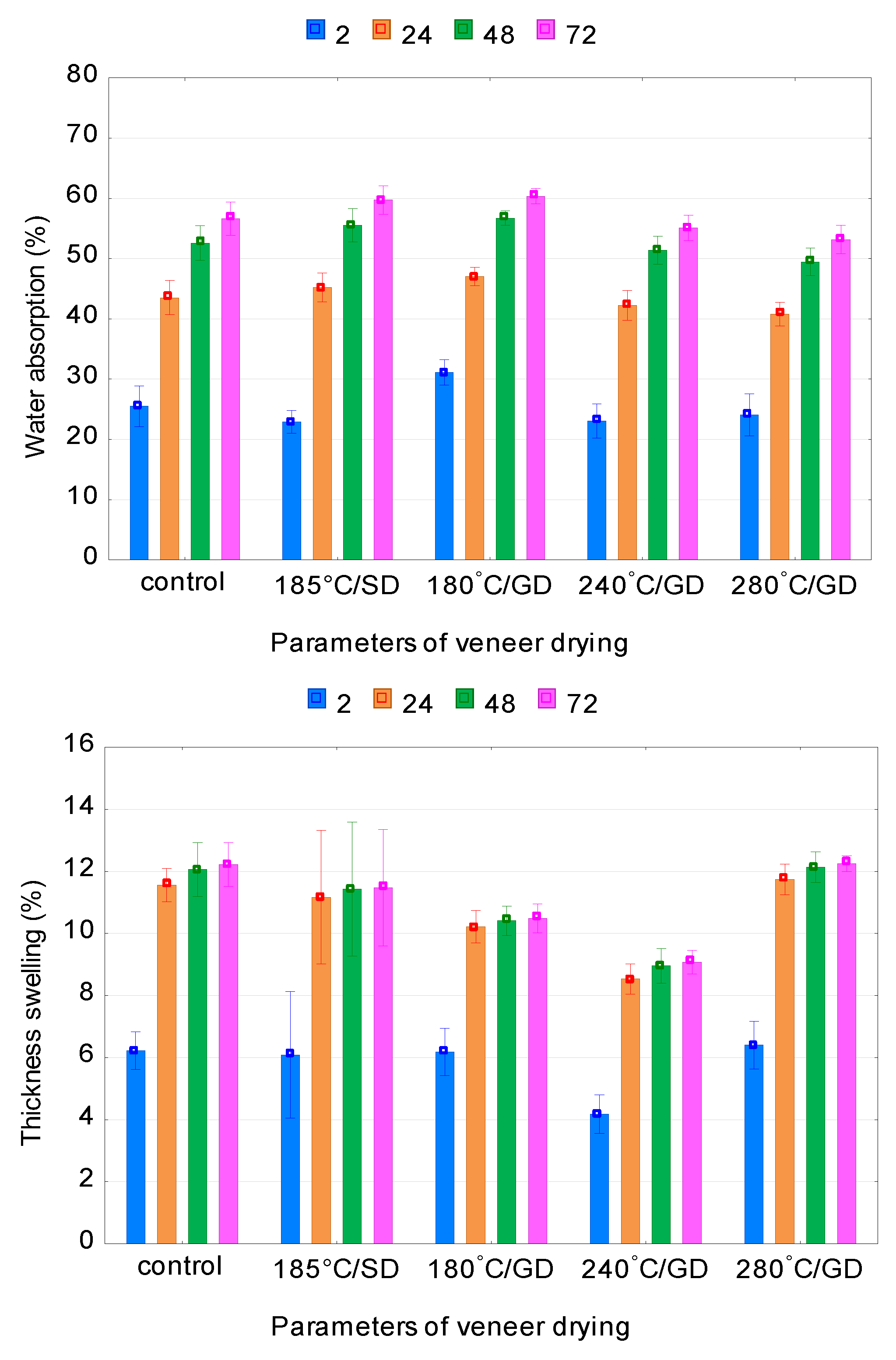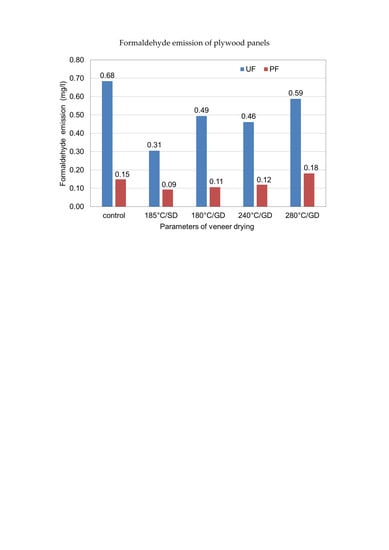Effect of Veneer-Drying Temperature on Selected Properties and Formaldehyde Emission of Birch Plywood
Abstract
1. Introduction
2. Materials and Methods
2.1. Materials
2.2. Plywood Panel Manufacturing
2.3. Panel Testing
2.4. Formaldehyde Release from Plywood
2.5. Analysis of Variance
3. Results and Discussion
3.1. Shear Strength of Plywood Samples
3.2. Formaldehyde Emission of Plywood Samples
3.3. Bending Strength and Modulus of Elasticity of Plywood Samples
- -
- along the fibres, between 118.1 and 139.7 MPa/131.0–172.8 MPa and 9301.5–10988.3 MPa/9930.4–13924.5 MPa, respectively;
- -
- across the fibres, between 24.2 and 27.8 MPa/25.5–31.2 MPa and 981.9–1351.6 MPa/1197.3–1560.7 MPa, respectively.
3.4. Water Absorption and Thickness Swelling of Plywood Samples
4. Conclusions
Author Contributions
Funding
Conflicts of Interest
References
- Kelly, T.J.; Smith, D.L.; Satola, J. Specific emission rates of formaldehyde from materials and consumer products found in California homes. Environ. Sci. Technol. 1999, 33, 81–88. [Google Scholar] [CrossRef]
- Formaldehyde, 2–Butoxyethanol and 1–tert–Butoxypropan–2–ol. In Monographs on the Evaluation of Carcinogenic Risk to Humans; World Health Organization–International Agency for Research on Cancer: Lyon, France, 2006; Volume 88, 478p.
- Roffael, E. Volatile organic compounds and formaldehyde in nature, wood and wood based panels. Holz Roh Werkst. 2006, 64, 144–149. [Google Scholar] [CrossRef]
- Wang, S.Y.; Yang, T.H.; Lin, L.T.; Lin, C.J.; Tsai, M.J. Properties of low-formaldehyde-emission particleboard made from recycled wood-waste chips sprayed with PMDI/PF resin. Build. Environ. 2007, 42, 2472–2479. [Google Scholar] [CrossRef]
- Amazio, P.; Avella, M.; Errico, M.E.; Gentile, G.; Balducci, F.; Gnaccarini, A.; Moratalla, J.; Belanche, M. Low formaldehyde emission particleboard panels realized through a new acrylic binder. J. Appl. Polym. Sci. 2011, 122, 2779–2788. [Google Scholar] [CrossRef]
- Meyer, B.; Boehme, C. Formaldehyde emission from solid wood. For. Prod. J. 1997, 47, 45–48. [Google Scholar]
- Weigl, M.; Wimmer, R.; Sykacek, E.; Steinwender, M. Wood-borne formaldehyde varying with species, wood grade, and cambial age. For. Prod. J. 2009, 59, 88. [Google Scholar]
- Hasegawa, A. The effect of drying temperature on chemical-substance emission from solid wood (in Japanese). J. Environ. Eng. AIJ 2009, 73, 1267–1273. [Google Scholar] [CrossRef]
- Schäfer, M.; Roffael, E. On the formaldehyde release of wood. Holz Roh Werkst. 2000, 58, 259–264. [Google Scholar] [CrossRef]
- Martinez, E.; Belanche, M.I. Influence of veneer wood species on plywood formaldehyde emission and content. Holz Roh Werkst. 2000, 58, 31–34. [Google Scholar] [CrossRef]
- Aydin, I.; Colakoglu, G.; Colak, S.; Demirkir, C. Effects of moisture content on formaldehyde emission and mechanical properties of plywood. Build. Environ. 2006, 41, 1311–1316. [Google Scholar] [CrossRef]
- Bohm, M.; Salem, M.Z.M.; Srba, J. Formaldehyde emission monitoring from a variety of solid wood, plywood, blockboard and flooring products manufactured for building and furnishing materials. J. Hazard. Mater. 2012, 221–222, 68–79. [Google Scholar] [CrossRef] [PubMed]
- Salem, M.Z.M.; Bohm, M.; Srba, J.; Berankova, J. Evaluation of formaldehyde emission from different types of wood-based panels and flooring materials using different standard test methods. Build. Environ. 2012, 49, 86–96. [Google Scholar] [CrossRef]
- Salem, M.Z.M.; Bohm, M. Understanding of Formaldehyde Emissions from Solid Wood: An Overview. BioResources 2013, 8, 4775–4790. [Google Scholar] [CrossRef]
- McDonald, A.G.; Gifford, J.S.; Steward, D.; Dare, P.H.; Riley, S.; Simpson, I. Air emission from timber drying: High temperature drying and re-drying of CCA treated timber. Holz Roh Werkst. 2004, 62, 291–302. [Google Scholar] [CrossRef]
- Jiang, T.; Gardner, D.J.; Baumann, M.G.D. Volatile organic compound emissions arising from the hot-pressing of mixed hardwood particleboard. For. Prod. J. 2002, 52, 66–77. [Google Scholar]
- Lutz, J.F. Wood Veneer: Log Selection, Cutting, and Drying; Technical Bulletin No. 1577; U.S. Department of Agriculture: Washington, DC, USA, 1978.
- Vick, C.B. Adhesive bonding of wood materials. In Wood handbook-Wood as an Engineering Material; Gen. Tech. Rep. FPL–GTR–113; U.S. Department of Agriculture, Forest Service, Forest Products Laboratory: Madison, WI, USA, 1999; Chapter 9; 463p. [Google Scholar]
- Baldwin, R.F. Veneer drying and preparation. In Plywood and Veneer-Based Products; Miller Freeman Books: San Francisco, CA, USA, 1995. [Google Scholar]
- Rice, R.W. Mass Transfer, Creep and Stress Development during the Drying of Red Oak. Ph.D. Thesis, Virginia Polytechnique Institute and State University, Blacksburg, VA, USA, 1988. [Google Scholar]
- Theppaya, T.; Prasertsan, S. Optimization of rubber wood drying by response surface method and multiple contour plots. Dry. Technol. 2004, 22, 1637–1660. [Google Scholar] [CrossRef]
- Frihart, C.R.; Hunt, C.G. Adhesives with wood materials, bond formation and performance. In Wood Handbook—Wood as an Engineering Material; General Technical Report FPL-GTR-190; U.S. Department of Agriculture, Forest Service, Forest Products Laboratory: Madison, WI, USA, 2010; Chapter 10. [Google Scholar]
- Aydin, I.; Colakoglu, G. Formaldehyde Emission, Surface Roughness, and Some Properties of Plywood as Function of Veneer Drying Temperature. Dry. Technol. 2005, 23, 1107–1117. [Google Scholar] [CrossRef]
- Christiansen, A.W. How overdrying wood reduces its bonding to phenolformaldehyde adhesives: A critical review of the literature, part I—Physical responses. Wood Fiber Sci. 1990, 22, 441–459. [Google Scholar]
- Lehtinen, M. Effects of Manufacturing Temperatures on the Properties of Plywood; TRT Report No 92; Helsinki University of Technology, Laboratory of Structural Engineering and Building Physics: Helsinki, Finland, 1998.
- River, B.H.; Gillespie, R.H.; Vick, C.B. Wood as an adherent. In Treatise on Adhesion and Adhesives; Minford, J.D., Ed.; Marcel Dekker, Inc.: New York, NY, USA, 1991; Volume 7, 230p. [Google Scholar]
- Nazerian, M.; Dahmardeh Ghalehno, M.; Bayat Kashkooli, A. Effect of wood species, amount of juvenile wood and heat treatment on mechanical and physical properties of laminated veneer lumber. J. Appl. Sci. 2011, 11, 980–987. [Google Scholar] [CrossRef]
- Nazerian, M.; Ghalehno, M.D. Physical and Mechanical Properties of Laminated Veneer Lumber Manufactured by Poplar Veneer. J. Agric. Sci. Technol. A 2011, 1, 1040–1045. [Google Scholar] [CrossRef]
- Jamalirad, L.; Doosthoseini, K.; Koch, G.; Mirshokraie, S.A. Physical and mechanical properties of plywood manufactured from treated red-heart beech (Fagus Orientalis L.) wood veneers. BioResources 2011, 6, 3973–3986. [Google Scholar]
- Jamalirad, L.; Doosthoseini, K.; Koch, G.; Mirshokraie, S.A.; Welling, J. Investigation on bonding quality of beech wood (Fagus orientalis L.) veneer during high temperature drying and aging. Eur. J. Wood Prod. 2012, 70, 497–506. [Google Scholar] [CrossRef]
- Murata, K.; Watanabe, Y.; Nakano, T. Effect of Thermal Treatment of Veneer on Formaldehyde Emission of Poplar Plywood. Materials 2013, 6, 410–420. [Google Scholar] [CrossRef] [PubMed]
- Zdravkovic, V.; Lovric, A.; Stankovic, B. Dimensional Stability of Plywood Panels made from Thermally Modified Poplar Veneers in the Conditions of Variable Air Humidity. Drvna Ind. 2013, 64, 175–181. [Google Scholar] [CrossRef]
- Demirkir, C.; Colakoglu, G.; Colak, S.; Aydin, I.; Candan, Z. Influence of Aging Procedure on Bonding Strength and Thermal Conductivity of Plywood Panels. Acta Phys. Pol. A 2016, 19, 1230–1234. [Google Scholar] [CrossRef]
- Kol, H.S.; Seker, B. Properties of laminated veneer lumber manufactured from heat treated veneer. Pro Ligno 2016, 12, 3–8. [Google Scholar]
- Bekhta, P.A. Veneer Production; Osnova: Kyjiv, Ukraine, 2003; 256p. [Google Scholar]
- EN 314-1. Plywood. Bonding Quality. Part 1: Test Methods; European Committee for Standardization: Brussels, Belgium, 2004. [Google Scholar]
- EN 314-2. Plywood. Bonding Quality. Part 2: Requirements; European Committee for Standardization: Brussels, Belgium, 1993. [Google Scholar]
- EN 310. Wood-Based Panels. Determination of Modulus of Elasticity in Bending and of Bending Strength; European Committee for Standardization: Brussels, Belgium, 1993. [Google Scholar]
- EN 317. Particleboards and Fiberboards. Determination of Swelling in Thickness after Immersion in Water; European Committee for Standardization (CEN): Brussels, Belgium, 1993. [Google Scholar]
- EN ISO 12460-4. Wood Based Panels. Determination of Formaldehyde Release. Part 4: Desiccator Method (ISO 12460-4:2016); European Committee for Standardization: Brussels, Belgium, 2016. [Google Scholar]
- Denig, J.; Wengert, E.M.; Simpson, W.T. Drying Hardwood Lumber; Gen. Tech. Rep. FPL–GTR-118; US Department of Agriculture, Forest Service, Forest Products Laboratory: Madison, WI, USA, 2000.
- Christiansen, A.W. Effect of overdrying of yellow-poplar veneer on physical properties and bonding. Holz Roh Werkst. 1994, 52, 139–149. [Google Scholar] [CrossRef]
- Dougal, E.F.; Krahmer, R.L.; Wellons, J.D.; Kanarek, P. Glueline characteristics and bond durability of southeast asian species after solvent extraction and planning of veneers. For. Prod. J. 1980, 30, 48–53. [Google Scholar]
- Neese, J.L.; Reeb, J.E.; Funck, J.W. Relating traditional surface roughness measures to glue-bond quality in plywood. For. Prod. J. 2004, 54, 67–73. [Google Scholar]
- Collett, B.M. A review of the surface and interfacial adhesion in wood science and related fields. Wood Sci. Technol. 1972, 6, 1–42. [Google Scholar] [CrossRef]
- Aydin, I. Activation of wood surface for glue bonds by mechanical pre-treatment and its effects on some properties of veneer surface and plywood panels. Appl. Sur. Sci. 2004, 233, 268–274. [Google Scholar] [CrossRef]
- Boonstra, M.J.; Van Acker, J.; Pizzi, A. Anatomical and molecular reasons for property changes of wood after full-scale industrial heat-treatment. In Proceedings of the Third European Conference on Wood Modification, Cardiff, UK, 15–16 October 2007; pp. 343–358. [Google Scholar]
- Tumen, I.; Aydemir, D.; Gunduz, G.; Uner, B.; Cetin, H. Changes in the Chemical Structure of Thermally Treated Wood. Bioresources 2010, 5, 1936–1944. [Google Scholar]
- Özşahin, Ş.; Aydin, İ. Prediction of the optimum veneer drying temperature for good bonding in plywood manufacturing by means of artificial neural network. Wood Sci. Technol. 2014, 48, 59–70. [Google Scholar] [CrossRef]
- Theander, O.; Bjurman, J.; Boutelje, J.B. Increase in the content of low-molecular carbohydrates at lumber surfaces during drying and correlations with nitrogen content, yellowing and mould growth. Wood Sci. Technol. 1993, 27, 381–389. [Google Scholar] [CrossRef]
- Fengel, D.; Wegener, G. Wood: Chemistry, Ultrastructure, Reactions; Walter de Gruyter Prees: Berlin, Germany, 1989. [Google Scholar]
- Salthammer, T.; Boehme, C.; Meyer, B.; Siwinski, N. Release of primary compounds and reaction products from oriented strand board (OSB). In Proceedings of the Healthy Buildings Conference, Singapore, 7–11 December 2003; pp. 160–165. [Google Scholar]
- Tudor, E.M.; Barbu, M.C.; Petutschnigg, A.; Réh, R.; Krišťák, Ľ. Analysis of Larch-Bark Capacity for Formaldehyde Removal in Wood Adhesives. Int. J. Environ. Res. Public Health 2020, 17, 764. [Google Scholar] [CrossRef] [PubMed]
- Spets, J.P.; Ahtila, P. Reduction of organic emissions by using a multistage drying system for wood-based biomasses. Dry. Technol. 2004, 22, 541–561. [Google Scholar] [CrossRef]
- EN 13353. Solid Wood Panels (SWP)–Requirements; European Committee for Standardization: Brussels, Belgium, 2008. [Google Scholar]
- Özşahin, Ş.; Demir, A.; Aydin, İ. Optimization of Veneer Drying Temperature for the Best Mechanical Properties of Plywood via Artificial Neural Network. Anatol. Environ. Anim. Sci. 2019, 4, 589–597. [Google Scholar] [CrossRef]
- Unsal, O.; Candan, Z.; Buyuksarı, U. Effects of thermal modification on surface characteristics of OSB panels. Wood Res. 2010, 55, 51–58. [Google Scholar]
- Zdravković, V.; Lovrić, A. Influence of thermal treatments on wettability and water spread on the surface of poplar veneer. In Proceedings of the First Serbian Forestry Congress, Belgrade, Serbia, 11–13 November 2010. [Google Scholar]
- Candan, Z.; Buyuksarı, U.; Korkut, S.; Unsal, O.; Cakicier, N. Wettability and surface roughness of thermally modified plywood panels. Ind. Crop. Prod. 2012, 36, 434–436. [Google Scholar] [CrossRef]
- Andor, T.; Lagaňa, R. Selected properties of thermally treated ash wood. Acta Fac. Xylologiae Zvolen 2018, 60, 51–60. [Google Scholar] [CrossRef]
- Zhang, Y.; Hosseinaei, O.; Wang, S.; Zhou, Z. Influence of hemicellulose extraction on water uptake behavior of wood strands. Wood Fiber Sci. 2011, 43, 1–7. [Google Scholar]





| Ingredients of Adhesive | Parts by Weight | |
|---|---|---|
| Urea–formaldehyde | UF resin (with 66% solid) | 100 |
| Wheat flour | 15 | |
| Hardener | 4 | |
| Phenol–formaldehyde | PF resin (with 47% solid) | 100 |
| Test No. | Manufacturing Conditions | ||||||
|---|---|---|---|---|---|---|---|
| Adhesive Type | Type of Drier | Temperature of Veneer Drying (°C) | Adhesive Spread Rate (g/m2) | Pressing Pressure (MPa) | Pressing Temperature (°C) | Pressing Time (min) | |
| 1 | UF | SD | 160 | 160 | 1.8 | 105 | 5/6 * |
| 2 | SD | 185 | |||||
| 3 | GD | 180 | |||||
| 4 | GD | 240 | |||||
| 5 | GD | 280 | |||||
| 6 | PF | SD | 160 | 160 | 1.8 | 145 | 5/6 * |
| 7 | SD | 185 | |||||
| 8 | GD | 180 | |||||
| 9 | GD | 240 | |||||
| 10 | GD | 280 | |||||
| Drying Temperature (°C) | Moisture Content (%) | Shear Strength (MPa) | |||
|---|---|---|---|---|---|
| UF | PF | ||||
| Dry Test | Wet Test | Dry Test | Wet Test | ||
| 160 °C/SD (control) | 6.6 | 2.27 (0.19) A | 1.81 (0.17) A | 2.97 (0.24) B | 1.78 (0.19) B |
| 185 °C/SD | 5.5 | 3.09 (0.22) C | 2.52 (0.12) B | 3.23 (0.12) C | 1.92 (0.16) B |
| 180 °C/GD | 6.2 | 3.02 (0.28) C | 2.67 (0.12) C | 2.57 (0.22) A | 1.85 (0.10) B |
| 240 °C/GD | 4.7 | 3.08 (0.20) C | 2.69 (0.18) C | 2.60 (0.21) A | 1.93 (0.23) B |
| 280 °C/GD | 4.8 | 2.75 (0.15) B | 2.48 (0.21) B | 2.56 (0.18) A | 1.61 (0.11) A |
| Drying Temperature (°C) | Bending Strength (MPa) | Modulus of Elasticity (MPa) | ||||||
|---|---|---|---|---|---|---|---|---|
| UF | PF | UF | PF | |||||
| MOR (‖) | MOR (ꓕ) | MOR (‖) | MOR (ꓕ) | MOE (‖) | MOE (ꓕ) | MOE (‖) | MOE (ꓕ) | |
| 160 °C/SD (control) | 130.5 (7.1) B | 26.2 (2.6) AB | 161.0 (9.9) C | 31.1 (5.1) C | 11,275.5 (905.9) B | 1229.6 (92.3) C | 14,888.3 (976.9) E | 1363.6 (135.6) B |
| 185 °C/SD | 118.1 (8.4) A | 25.1 (1.8) A | 145.8 (11.3) B | 29.6 (2.7) BC | 9301.5 (898.2) A | 1135.3 (64.2) B | 11,625.3 (471.3) B | 1277.5 (69.6) AB |
| 180 °C/GD | 126.3 (4.9) B | 24.2 (1.4) A | 146.6 (9.9) B | 27.0 (3.2) AB | 10,852.7 (786.5) B | 981.9 (22.0) A | 12,686.1 (858.0) C | 1232.8 (117.2) A |
| 240 °C/GD | 133.6 (10.4) BC | 25.5 (2.3) A | 131.0 (6.6) A | 25.5 (2.3) A | 9738.2 (901.5) A | 1111.4 (107.6) B | 9930.4 (620.3) A | 1197.3 (118.1) A |
| 280 °C/GD | 139.7 (7.6) C | 27.8 (3.0) B | 172.8 (11.4) D | 31.2 (4.5) C | 10,988.3 (743.4) B | 1351.6 (99.8) D | 13,924.5 (1015.4) D | 1560.7 (111.1) C |
© 2020 by the authors. Licensee MDPI, Basel, Switzerland. This article is an open access article distributed under the terms and conditions of the Creative Commons Attribution (CC BY) license (http://creativecommons.org/licenses/by/4.0/).
Share and Cite
Bekhta, P.; Sedliačik, J.; Bekhta, N. Effect of Veneer-Drying Temperature on Selected Properties and Formaldehyde Emission of Birch Plywood. Polymers 2020, 12, 593. https://doi.org/10.3390/polym12030593
Bekhta P, Sedliačik J, Bekhta N. Effect of Veneer-Drying Temperature on Selected Properties and Formaldehyde Emission of Birch Plywood. Polymers. 2020; 12(3):593. https://doi.org/10.3390/polym12030593
Chicago/Turabian StyleBekhta, Pavlo, Ján Sedliačik, and Nataliya Bekhta. 2020. "Effect of Veneer-Drying Temperature on Selected Properties and Formaldehyde Emission of Birch Plywood" Polymers 12, no. 3: 593. https://doi.org/10.3390/polym12030593
APA StyleBekhta, P., Sedliačik, J., & Bekhta, N. (2020). Effect of Veneer-Drying Temperature on Selected Properties and Formaldehyde Emission of Birch Plywood. Polymers, 12(3), 593. https://doi.org/10.3390/polym12030593







